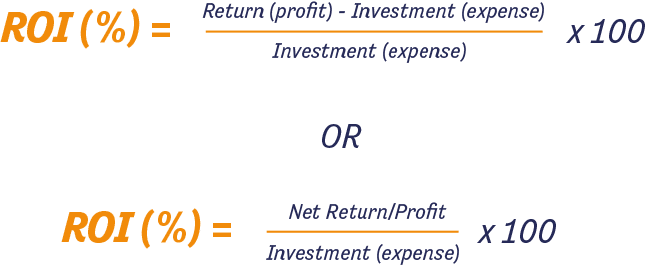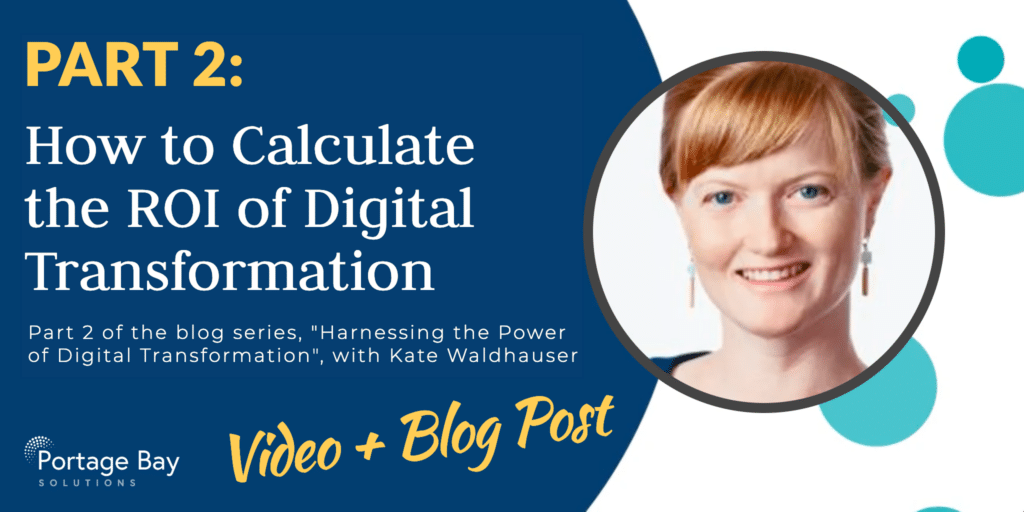WELCOME TO PART TWO OF FOUR
Welcome to the second part of this summer’s blog series – Harnessing the Power of Digital Transformation. In case you missed it, you can read part one of the series here: The Age of Digital Transformation and Why It Matters. I’m excited to share with you more in-depth insights into calculating the success of your digital transformation and using analytics to make future decisions.
Download our free Digital Transformation Tool
Key Factors in Decision Making for Maximizing Digital Transformation ROI
Are you one who can easily envision how an automated system will solve problems for your business, but you find yourself asking how you can show that the investment in the system will outweigh the costs of creating it? If you’ve found yourself asking this question, you are not alone.
I find that this question is asked by many, including CIOs, project managers, and key stakeholders. They all struggle to articulate and quantify returns on projects, particularly those without clear end dates and on projects that return soft results rather than clear profit.
COST BENEFIT ANALYSIS
Investing time and energy into building a strategic solution, integrations, and forward-thinking technology can add up, and at times it can feel like you are in the dark. How do we demonstrate the rewards for these efforts? In business, we use certain metrics to support our decision making. Return on investment (ROI) is one of the most valuable measurements of success. It is an excellent metric to help your company deliver maximum output and profit.
Sometimes it’s necessary to calculate the projected ROI in order to justify starting the project. Other times it’s wise to calculate the actual ROI so that you can make decisions about the next directions for a project. Custom software development has the potential to accomplish a wide variety of business goals, including improving your processes, providing a competitive advantage, or aiding decision making abilities, and I am very pleased to share with you my research, strategy and examples based on real solutions we have built for our clients.
I realize that tackling a topic as complex as the ROI of digital transformation is something which cannot be accomplished in this single blog post. I make no claims to be a financial expert, so please use this information as a launching pad on your own journey to calculate the success of your digital transformation.

THE RELATIONSHIP BETWEEN ROI AND KPIs
Using a basic calculation for digital transformation ROI is not always possible with technology projects. Although the formula is really quite simple, it’s not so straightforward to calculate reliably for custom software initiatives. Complexity arises because the benefits we are measuring do not always translate to a strict numeric value.

Choosing alternative metrics, such as key performance indicators (KPIs) is a wise step since KPIs are the measurements used to track the progress towards achieving a certain goal. Simply put, they measure if your business is meeting its targets. KPIs are used to demonstrate if you have a positive ROI.
DEVELOP A STRATEGY FOR EVALUATING YOUR CUSTOM SOFTWARE INITIATIVES
ASK, “WHY ARE WE DOING THIS?”
The first step to developing your strategy for evaluating your investment starts with asking yourself this basic question, “Why are we doing this?”
It may seem obvious, but getting down to the root of what you are trying to accomplish will help drive the direction of what kind of statistics are useful in measuring the success of your project. Another way to ask it is, “What are we hoping to accomplish?”
This Forbes article suggests narrowing down your motivation to a single objective, that can have a few distinct results, then asking yourself some questions about that objective, such as:
-
Do you want to promote transparency?
-
Will transparency have a positive domino effect in other departments?
-
Do you want to boost operational efficiency?
-
Will greater operational efficiency free up employee time for other responsibilities?
-
Are you trying to increase employee engagement?
-
Why is this goal important to your organization?
CHOOSE YOUR METRICS
After you have determined your primary goals, the next step is to start choosing metrics to support measuring your initiative. The metrics you choose will have to be very personalized to your business and industry as not every metric is applicable. Perhaps you just want to measure cost savings and increased revenue. After you know what you are trying to accomplish, start to choose the KPIs that can measure your specific objectives.
Paul Proctor, Distinguished VP Analyst at Gartner, provides some excellent insight throughout this article, some of which I’ve included for you here.
-
Select just 5 to 9 metrics to track, report and act on. The value of a metric lies in its ability to influence business decision making.
-
Choose KPIs you can measure easily.
-
Stop looking for a list everyone else is using, because done properly, someone else’s list won’t apply to your transformation. KPIs need to be industry-specific and then organization-specific to be meaningful and useful.
ASK FIVE KEY QUESTIONS
Gartner suggests continuing with these five key questions when creating a digital KPI:
What is being measured?
-
An example might be the percentage of customer interactions that are virtual/digital.
-
-
Where are we today?
-
What is our target goal?
What is our desired business outcome/benefit?
-
For example, 50% better customer outcomes and 20% lower cost.
-
What is our balance point, or the point of diminishing returns?
-
For example, a South American company might want to move all of its customers to mobile transactions, but in some countries 100% of consumers use a smartphone, while in other countries only 15% do.
-
The timelines by which you measure KPIs will also vary based on your company’s goals and the types of KPIs you are measuring.
FOUR GOALS COMMONLY PURSUED
I’ve outlined a variety of business goals below, along with concrete examples of digital solutions used to accomplish them and common KPIs used to measure their success. This list is by no means exhaustive and for the purpose of this blog post, I’ve chosen the four most common goals. These examples can be used as a starting point for considering your own metrics. The full list will appear in the accompanying white paper which will be released at the end of the blog series.
Also, keep in mind that the metrics are a mix of quantitative and qualitative. Determining the ROI of digital transformation in a strict calculation is not always possible, as the qualitative measurements are not as well defined and yet their value may be enormous.
Goal 1: Save Time With Workflow Automation
The most common type of digital transformation of ROI companies report is automation through software, or process automation. This means replacing common tasks with automated processes (something Claris products are excellent at!). In today’s tight job market, automating processes can make a big difference in streamlining those processes. Examples:
-
Automate data collection by creating a web based form or PDF form that is inserted automatically into your database with an alert sent to the person responsible for data collection.
-
Automate vacation requests by replacing a process that currently involves several steps – email, follow-up, meeting time, checking the calendar – with an automated Claris Connect flow that allows employees to submit a form and have it automatically sent to HR for approval via a one click button.
-
Auto-transfer data from email into systems of record and convert the email contents to actionable items, assigned to people to accomplish the tasks.
KPIs To Measure:
-
Gather average completion times for three to five time-consuming tasks.
-
After implementing new software, track those tasks for the next month.
-
Find the difference between average completion time for each task between both methods and multiply by 100 to get a percentage: (Average time) – (average time with new software) / (100) = (% of time saved)
-
Goal 2: Create New Business Opportunities
Is your goal to attract new business and create more sales? Factors that will result in increased sales after the software has been introduced need to be considered. Factors like direct customer-reach also play an integral role in increasing sales. Examples:
-
Create a modern CRM system to shorten sales cycles, respond more quickly, and ensure nothing slips through the cracks while also providing an in-depth analysis of what works to move leads to make purchases.
-
Introduce a new email marketing tool to grow your customer list and funnel more customers through the sales pipeline.
-
Add a new revenue stream by creating a subscription-based website full of virtual content that is in demand by your customers.
KPIs To Measure:
-
Boost in email open rates
-
Revenue from retargeted customers
-
Annual recurring revenue
-
Average revenue per user
-
Quota attainment
-
Win rate
-
Conversion rate
-
Sales cycle length
-
Average deal size
-
Average profit margin
-
Goal 3: Enhance Customer Experience
The customer experience will drive how customers react and think about your company. Maintaining a high level of customer service will increase your likelihood of sales conversions, lead to a greater number of customer recommendations, and invariably improve your public image. Examples:
-
Create a client facing mobile app or web portal to allow customers to log in and view their account, check on payments, review upcoming appointments, etc.
-
Build a custom Wiki to provide a searchable help site related to your product.
-
Build a workflow to receive customer feedback via SMS to automatically track the customer’s feedback in the database and alert the proper team to respond in a timely manner.
-
Build personalized customer experiences by using data, such as purchase history, to predict what products a customer may be interested in buying in the future.
KPIs To Measure:
-
Net promoter scores
-
Likelihood to recommend
-
Number of social media mentions
-
Social media sentiment
-
Customer reviews and feedback
-
Goal 4: Boost Employee Satisfaction
Employee retention has positive ripple effects which include improved employee loyalty, decreased hiring costs, more highly skilled employees, as well as improved customer experience with digital transformation ROI. I really cannot think of any company that wouldn’t benefit from boosted employee satisfaction. Examples:
-
Create a smooth and intuitive UX by revamping an outdated database that was difficult to navigate and required employees to “jump through hoops” to get their work done, by replacing it with a more modern, easy to use solution with an intuitive user experience based on user stories, thereby leading to an improved employee experience and greater job satisfaction.
-
Integrate your solution with teamwork platforms such as Slack to improve team communications and collaboration.
-
Create customizable dashboards and visualizations based on the user’s role, to allow them to view the data important to their position without being inundated with a wealth of information.
-
Listen to and request employee feedback on current software as well as new initiatives to ensure the software is meeting their needs, as well as help enable transparency in knowing the importance of the software.
KPIs To Measure:
-
Engagement scores
-
Collaboration
-
Likelihood to recommend
-
Turnover rate
-
Digital adoption
-
WHAT IF I DO NOTHING? CALCULATE THE NET LOSS FOR THAT
Calculate your net loss every year with your current process if you do nothing. Next, attempt to calculate your net gain with the software expense calculated into it as well. This example provides conservative guesses at what type of digital transformation of ROI a software project could deliver in the form of net new business, client growth, and productivity.
DON’T FORGET ABOUT INTANGIBLE ROI
Even though they’re not quantifiable by nature, intangible ROI can’t be overlooked and needs to be considered while evaluating the success of your project. These may include:
-
Having a competitive edge over your competitors gives your business the ability to do a lot of things more swiftly and accurately in comparison.
-
Employee morale and satisfaction are improved.
-
Building customer trust through transparency.
-
Increase in customers’ delight.
-
Automation and custom software can further differentiate your business from your competitors.
-
There is an improvement in goodwill in the market as your company will be seen as a forward-thinking company and one that keeps up with the latest technologies.
-
The reputation of your business increases as you become known as a company that keeps on improving their processes and keeps caring about their customers and employees.

Another intangible benefit is unlocking creativity; it’s what happens when we are in the process of solving one problem and a vision of completely new functionality is conceived. This is one of the most exciting parts about being a consultant helping clients to improve their businesses and using our expertise in Claris to demonstrate possibilities. I love unlocking them for myself and for Portage Bay Solutions as well.
WHAT’S NEXT?
I hope you have enjoyed reading this post and have been inspired to use metrics to demonstrate the value of your custom software. If you missed the first part of this series, click here to learn more about The Age of Digital Transformation and Why it Matters . Stay tuned for the next two posts coming up:
-
JULY: Real World Advice for Implementing a Successful Custom Software Project
-
AUGUST: Download a Free Tool to Help Guide You Through Your Process
